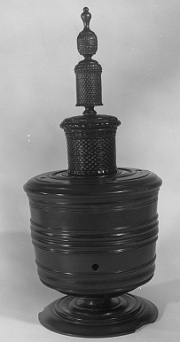

What could be more English than a good wassail? From the Anglo-Saxon ‘wael hael’—good health —the word refers to the tradition of ceremonial drinking of cider that survived strongly in southwest England. In 1599 Arthur Chichester brought this wassail bowl from his native Devon to Ulster. It can be seen as a token of the idea that took shape in the plantation of Ulster: making Ulster British. Chichester was a classic Elizabethan adventurer. During the Nine Years War he was in command in north-east Ulster; led an amphibious assault across Lough Neagh into central Ulster; and obviously kept his eye open for good land in south Antrim, which he was duly granted after victory had been achieved. In 1608, he used his position as Lord Deputy to claim and acquire the entire Inishowen peninsula; in the Ulster plantation, he acquired an estate that included Dungannon, thus symbolically occupying what had been Hugh O’Neill’s base of operations.
At first the attitude of the English government to the defeated Gaelic lords was conciliatory. The hope was that, suitably tamed, the Ulster aristocrats would settle down to administering the region for the crown. The Flight of the Earls marked the collapse of this policy. A bold new strategy began to take shape, partly at Chichester’s prompting: if the population could not be coerced or cajoled into loyalty, change the population, as the crown had attempted to do in Munster after the defeat of the earl of Desmond.
Even before the Irish lords left land speculators had begun colonising east Ulster, but the process was accelerated by the confiscation of the land of the departed earls. A failed rising by Sir Cahir O’Doherty in Derry allowed the state to seize his lands too. Thus, six of the nine counties of Ulster—Armagh, Cavan, Coleraine (Derry), Donegal, Fermanagh and Tyrone—were crown possessions. In 1610, as sanctioned by James I, 40 per cent of this land was allocated to English or Scots ‘undertakers’, with the rest allotted to soldiers who had fought in the Irish campaigns, loyal Irish chieftains, the Church of Ireland and government officials. Undertakers were obliged to replace native Irish with settlers within two years and to build a castle on their lands by 1613. The creation of urban settlements was a key part of the ‘civilising’ project. Derry, renamed Londonderry, was treated separately and assigned to the City of London.
The plantation did not go to plan. Many undertakers lacked the capital to create and sustain large-scale settlements. In 1610 Chichester wrote that ‘those from England are, for the most part, plain country gentlemen…If they have any money, they keep it close’. By 1630 the number of Scots in Ulster may have been as few as 16,000, with an even smaller number of English settlers. Undertakers had little choice but to keep on indigenous Catholics as tenants. This meant that there was less immediate social conflict than might have been expected. It also meant that Ulster evolved not as a model Protestant colony but as a much more complex and mixed society.